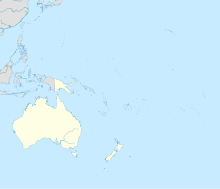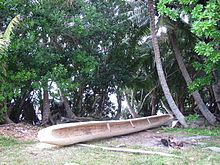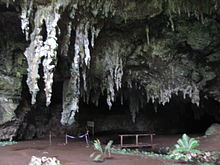Vao (Île des Pins)
Vao is the main town on the island of Île des Pins , which, together with a few uninhabited minor islands, forms a municipality in the southern province of New Caledonia , a French overseas territory in the Pacific .
geography
Vao is 6 km east of Kuto , the main port of the island, to which it is connected by a good road that is passable in all weather conditions. From Kuto, Nouméa , the capital of New Caledonia, can be reached by ferry three times a week. Ile des Pin airport is about 12 km north of Vao and there are three flights a day from Nouméa.
Vao is also one of the eight tribal areas of the Île des Pins, and with 572 inhabitants (435 tribesmen or résidents and 137 foreigners or non-résidents , as of 1996) the most populous.
Facilities and infrastructure
Vao with its town hall ( mairie ) is not only the administrative center, but also the school center of the island with its three schools. The girls 'school was founded in 1882 and the boys' school in 1893. The buildings are very well preserved and are still in use today. In the town center there are shops, the only post office on the island, the tourist information center, a small market hall and the island's health center with a doctor, dentist, midwife and nurses.
history
Ceramic finds made in 1943 in the Baie de Saint Maurice bay and now exhibited in the Musée de Nouvelle Calédonie in Nouméa show that the area of Vao was settled more than 2000 years ago . Fragments of obsidian from a quarry near Talasea on the island of New Britain in Papua New Guinea , which is over 3000 km away , were also found in the bay . This could mean that trade relations existed between what is now Papua New Guinea and the Île des Pins at the time.
In 1860 the construction of the Catholic Church Notre Dame de l'Assomption began in the south of the island , around which the village of Vao was built. The most powerful chief of the Ile des Pins also settled here. Before that he lived in Gadji in the north of the island, which was originally the most important town on the Ile des Pins.
Attractions
In addition to the Notre Dame de l'Assomption church , built in 1860 and redesigned several times , to which an avenue leads from the araucaria so typical of New Caledonia and the Ile des Pins , Vao, which is located on several bays, has a number of other sights.
A memorial on the market hall commemorates the islanders who died for France in the First and Second World Wars. Behind a palisade fence made of carved totem poles is the Chefferie , the residence of Hilarion Vandegous, the island's most important chief, who, along with seven other chiefs who report to him, manages the island.
At the Baie de Saint Maurice , where ceramics from the Lapita culture were found in 1943 , a memorial commemorates the arrival of the first Catholic missionaries on August 12, 1848, surrounded by a circle of carved totem poles from 1987.
Traditional pirogues , which are still used for fishing, are still built today at the Baie de Saint Joseph bay . Not far from the bay, which is also known as the Baie des Pirogues , a statue of St.Petersburg rises up as a sign of the pronounced religiousness of the inhabitants of the Ile des Pins. Josef, who is also surrounded by a ring of totem poles.
Above the village, the Notre Dame de la Salette chapel offers an impressive view of Vao and its surroundings, here is also the island's cemetery with the grave of Queen Hortense.
A few km north of Vao is the Grotte d'Oumagni , also known as the Grotte de la Reine Hortense . The daughter of Grand Chieftain Kaoua Vandegou is said to have hid in it for several months in 1855/56, as riots broke out after her father's death. The entrance to the grotto is at the end of a small valley with lush tropical vegetation, u. a. Impressive specimens of the genus Alpinia and cycads thrive here .
Web links
Individual evidence
- ↑ District Coutumier Ile des Pins
- ↑ Pierre Grundmann: Nouvelle Calédonie , p. 179. Paris 2012
- ↑ Christophe Sand: Archeology in New Caledonia , p. 33. Nouméa 1993
- ↑ Pierre-Alain Pantz: Ile des Pins - merveille de la nature , p. 81. Nouméa 2008
- ↑ Pierre Grundmann: Nouvelle Calédonie , p. 181. Paris 2012
- ↑ Michael Brillat: Südsee , p. 81. Munich 2012
- ↑ Michael Brillat: Südsee , p. 82. Munich 2012
Coordinates: 22 ° 40 ′ S , 167 ° 30 ′ E





